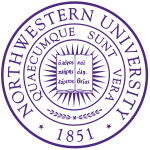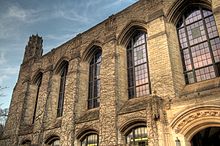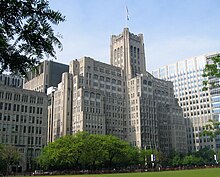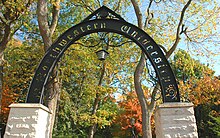History of Northwestern University
[4] John Evans purchased 379 acres (153 ha) of land along Lake Michigan in 1853 and Philo Judson began developing the plans for what would become the city of Evanston.
J. Roscoe Miller's tenure, from 1949 to 1970, was responsible for the expansion of the Evanston campus with the construction of the Lakefill on Lake Michigan, growth of the faculty and new academic programs, as well as polarizing Vietnam-era student protests.
Tensions between the Evanston community and the university were strained throughout much of the post-war era given episodes of disruptive student activism, Northwestern's exemption from property tax obligations, as well as restrictions on the sale of alcohol near campus under the original charter although the latter ban was lifted in 1972.
The political and cultural environment of the mid-nineteenth century resulted in individual states granting charters to hundreds of small colleges rather than a few centralized national institutions as was typical in European countries.
[13] These colleges were highly sectarian and were motivated by the desire to both increase the quality of ministerial training as well as to discourage its young people from attending schools controlled by rival denominations.
[13] On May 31, 1850, John Evans, Grant Goodrich, Henry W. Clark, Andrew Brown, Orrington Lunt, Jabez Botsford, Richard Haney, Richard H. Blanchard, and Zodoc Hall met in a law office above a hardware store at 69 West Lake Street in Chicago and resolved that "the interests of sanctified learning require the immediate establishment of a university in the Northwest under the patronage of the Methodist Episcopal Church.
[14][15] Despite their evangelism, the founders were committed to the establishment of a non-sectarian institution reflecting both the worldly educational philosophy of the Methodist movement and the political realities of the Illinois state legislature adverse to chartering church-affiliated colleges.
[4][13][a] Evans and Lunt initially each donated $5,000 to endow the university which permitted them to purchase 16 lots on the northeast corner of Jackson Boulevard and LaSalle Street for $8,000 as a potential site for the campus.
Following Hinman's recommendation, Lunt began to survey for land that was both north of the city and abutting railways for a new university in the areas of Jefferson Park and Ridgeville.
Unable to find available land on the north shore up to Lake Forest, the committee was ready to purchase farmland to the west of the city when Orrington Lunt insisted on one final visit to the present location.
In 1854, Philo Judson, Northwestern's business manager charged with surveying and plotting this real estate nicknamed the land "Evanston" in honor of founder John Evans.
[27] In the antebellum period, campus literary societies had sponsored debates on secession and slavery although the predominantly Methodist administration, faculty, and student body was staunchly abolitionist.
[27] In 1869, the trustees voted to admit women to the university "under the same terms and conditions as young men" and Evanston resident, Rebecca Hoag, became the first female student to enroll.
The book on the seal was also altered to include the Greek text "ό λόγος πλήρης χάριτος καί άληθείας" (ho logos pleres charitos kai aletheias) from John 1:14 meaning "The Word ... full of grace and truth".
[40] In 1891, Knowlton L. Ames was appointed Northwestern's first football coach and work began constructing a stadium at the north end of campus that would be named Sheppard Field in honor of the university's business manager and lumber donor.
[51] Completed in 1940, Scott Hall was designed by Rogers and featured an auditorium, offices for student and alumni organizations, conference and social rooms, and apartments for university guests.
Construction required relocating the Phi Kappa Psi fraternity house and Dearborn Observatory and demolishing Patten Gymnasium, which had been designed by George Washington Maher.
[71] The university admitted students who had finished three years of high school as well as instituting summer sessions to allow them to complete their degree requirements before the minimum draft age of 20.
The scale and importance of these programs led the Navy to cordon off the Lunt Building, Swift Hall, and Shanley Pavilion as well as taking over the dormitories and fraternities on the north campus.
[73] In 1942, Snyder ordered that students of Japanese descent be barred from enrolling to comply with his interpretation of government internment policy, although this controversial decision was reversed after an outcry from the press and community.
[76][77][78] Dozens of Quonset huts and other temporary structures were erected near Dyche Stadium, on the meadow in front of the Deering Library, and elsewhere on campus to house the influx of students returning to complete their educations under the G.I.
[91] While Evanston and Chicago did not have the most oppressive Jim Crow laws in the country, in the post-War era the university and surrounding community remained highly conservative and resistant to changes in traditional social practices.
[93] For example, when future mayor of Evanston, Lorraine H. Morton attended Northwestern in the early 1940s, she was not allowed to live in on-campus accommodations and had to board in a private home nearby.
Although the administration rejected demands for racial preferences in admissions and financial aid, it made several concessions regarding desegregation, increasing student participation in policy matters, and developing a Department of African-American Studies.
[108] Demonstrations mainly stemmed from student opposition to the Vietnam War but also included protests against the draft, Navy ROTC, defense industry corporations, and the Nixon administration as well as supporting affirmative action, environmentalism, women's rights, and other instances of New Left social activism.
[112][113] The student protesters demanded that campus security be disarmed, the university endowment divest itself from "war stocks", and Northwestern's NROTC program be stripped of academic credit and its facilities turned into a childcare center.
The post remained vacant for sixteen months until Robert Strotz, a member of the Economics faculty since 1947 and dean of the College of Arts and Sciences since 1966, was unanimously elected by the trustees to be president in July 1970.
[121] When Arnold R. Weber was elected president in 1985, the university not only was in the midst of a funding crisis after cuts in federal aid but was also suffering from diminished national prestige.
[126] Northwestern also attracted controversy in 1991 for hiring former Weather Underground and FBI Ten Most Wanted Fugitive Bernardine Dohrn as an adjunct faculty member in the Law School.
[141][142] Henry S. Bienen, a political scientist and dean of Princeton University's Woodrow Wilson School of Public and International Affairs, was elected president of Northwestern in June 1994.














